The NVIDIA GeForce GTX 1650 Super Review, Feat. Zotac Gaming: Bringing Balance To 1080p
by Ryan Smith on December 20, 2019 9:00 AM ESTPower, Temperature, & Noise
Last, but not least of course, is our look at power, temperatures, and noise levels. While a high performing card is good in its own right, an excellent card can deliver great performance while also keeping power consumption and the resulting noise levels in check.
| GeForce Video Card Voltages | |||||
| 1650S Max | 1660 Max | 1650S Idle | 1660 Idle | ||
| 1.05v | 1.05v | 0.65v | 0.65v | ||
If you’ve seen one TU116 card, then you’ve seen them all as far as voltages are concerned. Even with this cut-down part, NVIDIA still lets the GTX 1650 Super run at up to 1.05v, allowing it to boost as high as 1950MHz.
| GeForce Video Card Average Clockspeeds | ||||
| Game | GTX 1660 | GTX 1650 Super | GTX 1650 | |
| Max Boost Clock | 1935MHz | 1950MHz | 1950MHz | |
| Boost Clock | 1785MHz | 1725MHz | 1695MHz | |
| Shadow of the Tomb Raider | 1875MHz | 1860MHz | 1845MHz | |
| F1 2019 | 1875MHz | 1875MHz | 1860MHz | |
| Assassion's Creed: Odyssey | 1890MHz | 1890MHz | 1905MHz | |
| Metro: Exodus | 1875MHz | 1875MHz | 1860MHz | |
| Strange Brigade | 1890MHz | 1860MHz | 1860MHz | |
| Total War: Three Kingdoms | 1875MHz | 1890MHz | 1875MHz | |
| The Division 2 | 1860MHz | 1830MHz | 1800MHz | |
| Grand Theft Auto V | 1890MHz | 1890MHz | 1905MHz | |
| Forza Horizon 4 | 1890MHz | 1875MHz | 1890MHz | |
Meanwhile the clockspeed situation looks relatively good for the GTX 1650 Super. Despite having a 20W lower TDP than the GTX 1660 and an official boost clock 60MHz lower, in practice our GTX 1650 Super card is typically within one step of the GTX 1660. This also keeps it fairly close to the original GTX 1650, which boosted higher in some cases and lower in others. In practice this means that the performance difference between the three cards is being driven almost entirely by the differences in CUDA core counts, as well as the use of GDDR6 in the GTX 1650 Super. Clockspeeds don’t seem to be a major factor here.
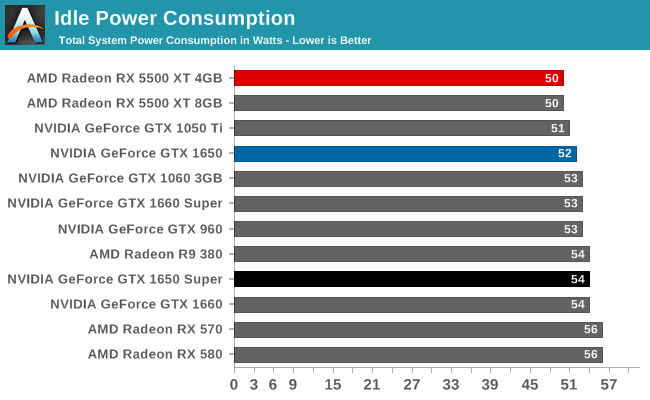
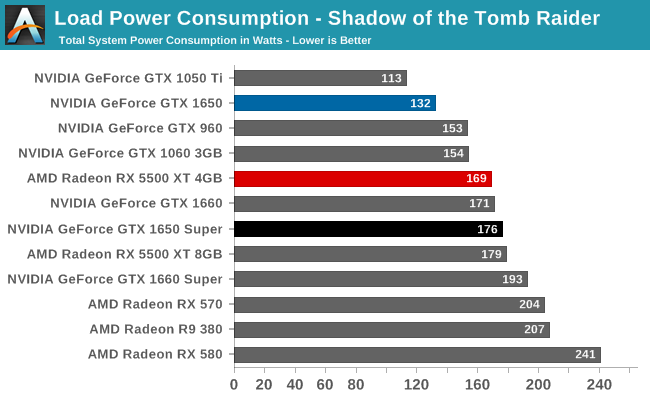

Shifting to power consumption, we see the cost of the GTX 1650 Super’s greater performance. It’s well ahead of the GTX 1650, but it’s pulling more power in the process. In fact I am a bit surprised by just how close it is (at the wall) to the GTX 1660, especially under Tomb Raider. While on paper it has a 20W lower TDP, in practice it actually fares a bit worse than the next level TU116 card. It’s only under FurMark, a pathological use case, that we see the GTX 1650 Super slot in under the GTX 1660. The net result is that the GTX 1650 Super seems to be somewhat inefficient, at least by NVIDIA standards. It doesn’t save a whole lot of power versus the GTX 1660 series, despite the lower performance.
Which also means it doesn’t fare especially well against the Radeon RX 5500 XT series. As with the GTX 1660, the RX 5500 XT is drawing less power than the GTX 1650 Super under Tomb Raider. It’s only by maxing out all of the cards with FurMark that the GTX 1650 Super pulls ahead. In practice I expect real world conditions to be between these two values – Tomb Raider may be a bit too hard on these low-end cards – but regardless, this would put GTX 1650 Super only marginally ahead of RX 5500 XT.
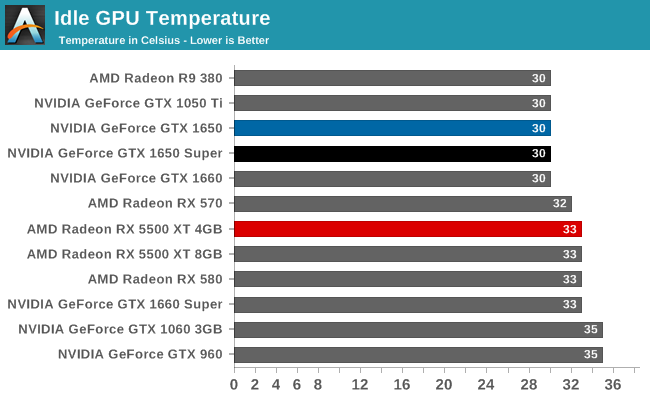
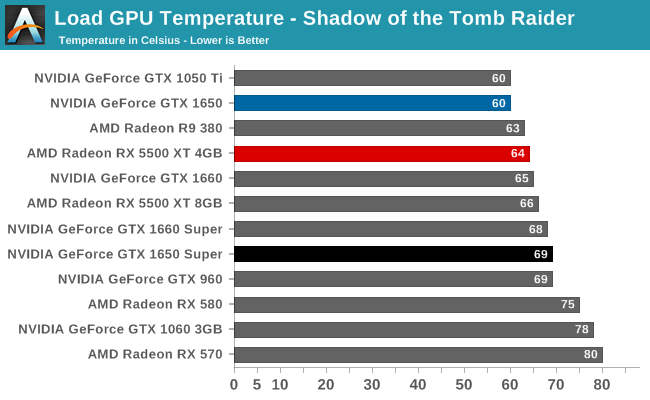
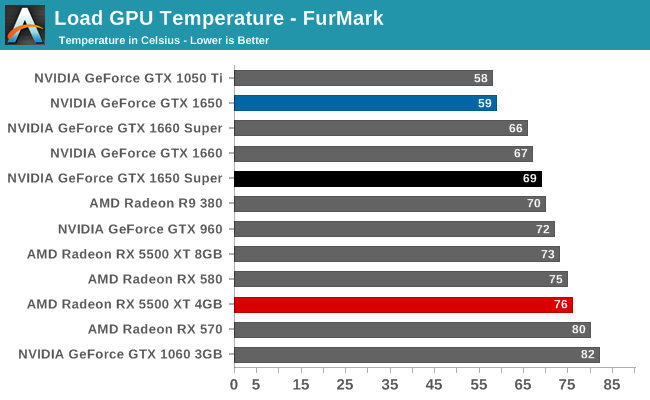
Looking at GPU temperatures, Zotac’s GTX 1650 Super card puts up decent numbers. While the 100W card understandably gets warmer than it’s 75W GTX 1650 sibling, we never see the GPU temperatures cross 70C. The card is keeping plenty cool.

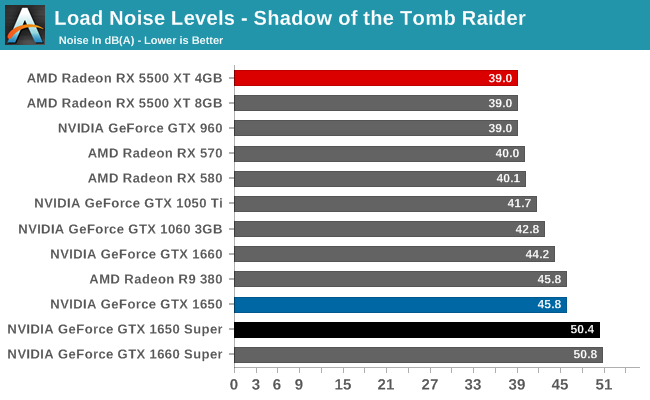

But when it comes time to measure how much noise the card is producing, we find a different picture. In order to keep the GPU at 69C, the Zotac GTX 1650 Super’s fans are having to do some real work. And unfortunately, the small 65mm fans just aren’t very quiet once they have to spin up. To be sure, the fans as a whole aren’t anywhere near max load – we recorded just 55% as reported by NVIDIA’s drivers – however this is still enough to push noise levels over 50 dB(A).
Zotac’s single-fan GTX 1650 card didn’t fare especially well here either, but by the time we reach FurMark, the GTX 1650 Super does even worse. It’s louder than any GTX 1660 card we’ve tested, even marginally exceeding the GTX 1660 Super.
All of this makes for an interesting competitive dichotomy given last week’s launch of the Radeon RX 5500 XT. The card we test there, Sapphire’s Pulse RX 5500 XT, is almost absurd in how overbuilt it is for a 130W product, with a massive heatsink and equally massive fans. But it moves more heat than Zotac’s GTX 1650 Super with a fraction of the noise.
If nothing else, this is a perfect example of the trade-offs that Sapphire and Zotac made with their respective cards. Zotac opted to maximize compatibility so that the GTX 1650 Super would fit in virtually any machine that the GTX 1650 (vanilla) can fit in, at the cost of having to use a relatively puny cooler. Sapphire went the other direction, making a card that’s hard to fit in some machines, but barely has to work at all to keep itself cool. Ultimately neither approach is the consistently better one – despite its noise advantage, the Sapphire card’s superiority ends the moment it can’t fit in a system – underscoring the need for multiple partners (or at least m multiple board designs). Still, it’s hard to imagine that Zotac couldn’t have done at least a bit better here; a 50 dB(A) card is not particularly desirable, especially for as something as low-powered as a GTX 1650 series card.










67 Comments
View All Comments
StevoLincolnite - Sunday, December 22, 2019 - link
But if you only paid $100 and it only lasts for a couple years, it's still worth it for that tier of performance, no?Yojimbo - Monday, December 23, 2019 - link
We don't have any data on this, which is why I would avoid a used mining card. We'll never get any data on this, either. The thing is, although one can't tell a well-cared-for gaming card from one not well-cared for, over the years a general knowledge of the expectation of a used part has been built up. In the case of mining it is a big unknown in my view. You don't really know which cards are mining cards and which are gaming, so any card that has been popular with miners is suspect, in my view, unless you know who you are buying from.eastcoast_pete - Sunday, December 22, 2019 - link
Which poses this question: Is there a program ("app") that can run a health check on a card? In addition to any "custom BIOS" , I would also be concerned about simple aging with intense, ongoing use. When manufacturers bin chips and assign them to target speeds, they supposedly do so also based on life expectancy, at least for CPUs. So, is there a way to test how much life the GPU and RAM of a card have left in them?flyingpants265 - Sunday, December 22, 2019 - link
The elephant in the room for the RX580 8GB, and AMD videocards in general, is the almost 200W power draw on a "1080p card", whereas the 1650 uses 75W. It may really suck for the price, but it uses less than half the power. Obviously the RX570 is a great choice as well.Then there's reliability. I've seen statistics from Puget systems and some big online retailer and AMD had some obscenely high failure rates. AMD is a much smaller company, they might have less oversight, and heat causes a lot of damage to complex electronics. Not exactly reliable info but I wouldn't really be surprised if it were somewhat accurate. I believe all consumer products are cheaply made, so I'd rather go with the lower-power, lower-heat, larger company. Too bad I don't have any hard data to back that up.
Not really interested in anecdotal evidence either.
Spunjji - Monday, December 23, 2019 - link
"Too bad I don't have any hard data to back that up.Not really interested in anecdotal evidence either."
Next time start with that pitch, so folks can ignore the self-confessedly uninformed speculative rambling that follows.
If the power draw is a bother on the RX580, a little undervolting will go a very long way without noticeably affecting frame rates at 1080p. It'll also help with longevity. Regardless, none of this is particularly crucial when you're saving ~$50 and getting a faster card with more VRAM.
Spunjji - Monday, December 23, 2019 - link
RX 580 is still good for 1440p too, if you're not obsessed with hitting "Max" on every setting just because it's there.khanikun - Monday, December 30, 2019 - link
Reminds me of back in the day, when I moved to ATI for a very short while. 9700 Pro. Started overheating after a year, then broke. 9600 XT as temporary card. Started overheating in less than a year. 9800 XT. Started overheating in a couple months. Went back to Nvidia and haven't had a reason to look at ATI/AMD cards since.Qasar - Wednesday, January 1, 2020 - link
i have some of those cards from then, 9800pro, 9600pro, used them not to long ago to see if they still work.. and they still do.. heheheheWetKneeHouston - Monday, January 20, 2020 - link
I think it makes sense to think that heat and power would lead to reliability issues. That's why I went with the 1650 Super. It's still too powerful of a card for the low tier (I can't notice the difference with higher settings, I suspect it's a scam lol) 1080p gaming I do, so I probably should have gotten the regular 1650, but they're basically the same price,Yojimbo - Friday, December 20, 2019 - link
Yeah maybe if it cost $50 it would be worth it for running dosbox.